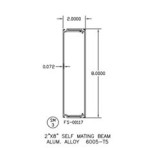How To Stain a Stamped Concrete Patio
Stamped concrete patios offer a beautiful and durable outdoor living space, mimicking the look of natural stone, brick, or tile at a fraction of the cost. While initially colored during the stamping process, the color can fade over time due to weathering and UV exposure. Staining is a beneficial way to refresh the appearance of a stamped concrete patio, enhance its existing color, or completely change its aesthetic. This article provides a comprehensive guide on how to stain a stamped concrete patio, ensuring a professional-looking and long-lasting finish.
Before commencing any staining project, thorough preparation is crucial. This includes assessing the condition of the concrete, selecting the appropriate stain, gathering the necessary tools and materials, and meticulously cleaning the surface. Skipping any of these preliminary steps can lead to unsatisfactory results, such as uneven color, poor adhesion, or premature fading.
Assessing the Concrete and Choosing the Right Stain
The first step is to evaluate the condition of the stamped concrete patio. Examine the surface for cracks, chips, stains, or any other damage. Small cracks can often be patched with concrete repair compound before staining, but larger cracks may require professional attention. Identify any existing stains, such as oil or grease, as these can affect the stain's absorption and color. Knowing the type of sealer previously applied, if any, is also essential. Some sealers may need to be removed before staining to ensure proper penetration.
Selecting the appropriate stain is paramount to achieving the desired aesthetic and ensuring longevity. There are two primary types of concrete stains: acid-based and water-based. Each offers distinct advantages and disadvantages.
Acid-based stains, also known as chemical stains, react chemically with the concrete, creating a permanent color change. They penetrate deeply into the concrete, resulting in a highly durable and fade-resistant finish. Acid stains produce earthy, mottled tones and are ideal for achieving a natural, aged look. However, they are corrosive and require careful handling and disposal. Acid stains also offer a limited color palette, typically in shades of browns, tans, and greens. They also react differently with different sections of the concrete, producing a varied and natural concrete look.
Water-based stains, also known as acrylic stains, are more user-friendly and environmentally friendly than acid-based stains. They contain pigments that bond to the concrete surface, providing a wider range of vibrant colors. Water-based stains are less reactive than acid stains, offering more consistent color across the entire patio. They are also easier to apply and clean up. However, water-based stains typically do not penetrate as deeply as acid stains and may be more susceptible to fading over time, especially in areas with heavy foot traffic or intense sun exposure. Newer water-based stains may also have the addition of polymers or other additives to increase their ability to penetrate and bind.
Consider the desired aesthetic, the level of durability required, and the ease of application when choosing between acid-based and water-based stains. Always test the chosen stain in an inconspicuous area before applying it to the entire patio to ensure the color and effect are satisfactory. Purchasing small quantities of different stains can assist in creating test areas.
In addition to the type of stain, the color selection is crucial. Consider the existing color of the concrete, the surrounding landscape, and the overall style of the home. Lighter colors can brighten up a patio, while darker colors can create a more dramatic or sophisticated look. Use online tools to visualize colors.
Preparing the Stamped Concrete Patio for Staining
Proper surface preparation is the most critical step in ensuring a successful staining project. A clean, porous surface allows the stain to penetrate evenly and bond properly, resulting in a durable and long-lasting finish. The cleaning process is crucial for the stain adhering uniformly.
Start by removing all furniture, plants, and other objects from the patio. Sweep or vacuum the surface to remove loose debris, dirt, and leaves. Next, thoroughly clean the concrete with a concrete cleaner or degreaser. These products are designed to remove oil, grease, and other contaminants that can interfere with the stain's adhesion. Follow the manufacturer's instructions for application and rinsing.
For stubborn stains or areas with heavy build-up, use a pressure washer with a wide-angle nozzle. Be careful not to damage the stamped concrete surface by using too much pressure or holding the nozzle too close. If no pressure washer is available, scrub the patio with a stiff-bristled brush and a mixture of soap and water. Allow the patio to dry completely before proceeding to the next step.
If the patio has been previously sealed, the sealer may need to be removed to allow the stain to penetrate the concrete. Different types of sealers require different removal methods. Some sealers can be removed with a chemical stripper, while others may require mechanical abrasion. Follow the manufacturer's instructions for the chosen removal method. After removing the sealer, thoroughly rinse the patio and allow it to dry completely. Once the surface is dry, tape off any areas that are not to be stained, such as walls or landscaping features. Use painter’s tape to create borders and prevent the stain from bleeding onto these areas.
For acid-based stains, it is often recommended to lightly etch the concrete surface with a mild acid solution. This opens up the pores of the concrete and allows the stain to penetrate more deeply. Follow the manufacturer's instructions for etching the concrete. Be sure to wear appropriate safety gear, including gloves and eye protection, when working with acid. After etching, thoroughly rinse the patio and allow it to dry completely.
Applying the Concrete Stain
Prior to applying the stain, read the staining manufacturer's instructions to prepare the stain. Different stains may require specific mixing or dilution steps. Follow these instructions carefully to ensure proper application and color consistency. Always wear appropriate safety gear, including gloves, eye protection, and a respirator, when applying concrete stain. This will protect you from potential chemical exposure.
There are several methods for applying concrete stain, including using a sprayer, a brush, a roller, or a sponge. A sprayer is ideal for covering large areas quickly and evenly. Use a pump sprayer with an adjustable nozzle to control the spray pattern. Apply the stain in thin, even coats, overlapping each pass slightly. A brush is useful for applying stain to edges, corners, and other tight areas. Use a natural-bristle brush for acid-based stains and a synthetic-bristle brush for water-based stains. A roller can be used to apply stain to large, relatively smooth surfaces. Use a short-nap roller for even coverage. A sponge can be used to create unique textures and effects. Experiment with different sponge shapes and application techniques to achieve the desired look.
Regardless of the application method, it is important to apply the stain in thin, even coats. Multiple thin coats are better than one thick coat, as this prevents drips, runs, and uneven color. Allow each coat to dry completely before applying the next coat. The drying time will vary depending on the type of stain, the temperature, and the humidity. Refer to the manufacturer's instructions for recommended drying times.
For acid-based stains, the color will continue to develop over time as the stain reacts with the concrete. Allow the stain to react for the recommended time period before neutralizing it. To neutralize an acid stain, use a solution of baking soda and water. Apply the solution to the stained surface and scrub with a brush. Rinse thoroughly with water and allow the patio to dry completely.
Once the stain has dried completely, apply a concrete sealer to protect the stained surface from wear, weathering, and fading. Choose a sealer that is compatible with the type of stain used. Follow the manufacturer's instructions for application. Apply the sealer in thin, even coats, allowing each coat to dry completely before applying the next coat. Typically, two coats of sealer are recommended for optimal protection.
Allow the sealer to cure completely before placing furniture or other objects on the patio. The curing time will vary depending on the type of sealer, the temperature, and the humidity. Refer to the manufacturer's instructions for recommended curing times. Proper application and curing of the sealer significantly extend the life and beauty of the stained concrete patio. By following these steps, staining a stamped concrete patio can be a rewarding project and will revitalize an outdoor space.

Concrete Stain And Sealer Patio Makeover Exchange

How To Stain Stamped Concrete You Can Do It Yourself

What Is Stamped Concrete Decorative Or Pavers Better

A Stamped Concrete Overlay Las Vegas Nv Patio Pool Deck

Stamped Stenciled Stained Concrete

How To Stain Concrete Patio Direct Colors

Decorative Concrete Stamped Stained Denton

The Pros And Cons Of Stamped Concrete Patios Driveways

Restoring Color To A Stamped Concrete Patio

The Difference Between Stamped Concrete And Stained Huston Contracting








